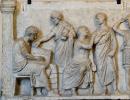What sciences does physics belong to? The concept of science and classification of sciences. Classification of sciences by subject of research
How, for example, they consider the objects they study in development and, therefore, turn out to be close to the humanities, namely to the sciences of the historical series. Dr. natural sciences, such as geography or physical science, formulate comparative assessments and gravitate toward social sciences, such as economics. The field of natural sciences is therefore very heterogeneous. The differences between individual natural sciences are so great that it is impossible to single out any one of them as a paradigm of “natural scientific knowledge.” The idea of neopositivism, which is the model that all other sciences (excluding formal ones) should be guided by, is counterproductive. Physics is not capable of serving as a model even for the natural sciences themselves. Neither cosmology, nor, especially, physical anthropology are similar in their essential features to physics. An attempt to extend the methodology of physics, taken to any full extent, to these scientific disciplines cannot lead to success, nevertheless, there is a certain unity of the natural sciences: they strive to describe the fragments of reality they study, and not to evaluate them; The descriptions given by these sciences are usually formulated in terms of comparative concepts rather than absolute ones (temporal “earlier-later-simultaneously”, spatial relations “closer-further”, causal, relation “more likely than”, etc.).
Social sciences include economics, sociology, social psychology, etc. It is characteristic of these sciences that they not only describe, but also evaluate, and in an obvious way they gravitate not towards absolute, but towards comparative assessments, as well as towards comparative concepts in general. The humanities include historical sciences, linguistics (individual), etc. Some of these sciences gravitate towards pure descriptions (for example), others combine them with assessment, and prefer absolute assessments (for example, psychology). The humanities use, not comparative, but absolute ones (the time series “was-is-will be”, spatial characteristics “here-there”, predestination, or fate, etc.). The field of social sciences and humanities is even more heterogeneous than the field of natural sciences. The idea of finding a scientific discipline that could serve as a model of socio-humanitarian knowledge is unrealistic. A history that tries to avoid judgment and always discusses the past only from a perspective. the present cannot serve as a model for sociology or economics, which involve explicit and implicit comparative assessments and use an earlier-simultaneous-later time series that does not imply a “present”; political sciences are not able to provide any models for psychology or linguistics, etc. The search for a paradigmatic social or humanitarian discipline is even more utopian than the search for a “model” natural science.
Between the social and human sciences proper lie sciences that can be called normative: ethics, aesthetics, art criticism, etc. These sciences form, like the social sciences, assessments (and their particular norms), but the assessments they give are, as a rule, not comparative, but absolute. In the use of absolute assessments, normative sciences resemble the humanities themselves, which always reason in the coordinates of absolute categories.
Mathematics also belongs to the formal sciences. Their approach to the objects under study is so abstract that the results obtained are used in the study of all areas of reality.
Cited by Ph.D. relies on two oppositions: “description” and “absolute concepts - comparative concepts.” All sciences are first divided into natural sciences, which tend to be described in a system of comparative categories, and social and human sciences, which tend to be assessed in a system of absolute categories; then the latter are divided into social, normative and human sciences. This is not the only possible one. There are various other bases for the division of sciences.
Philosophy: Encyclopedic Dictionary. - M.: Gardariki. Edited by A.A. Ivina. 2004 .
See what “CLASSIFICATION OF SCIENCES” is in other dictionaries:
Encyclopedia of Sociology
Disclosure of the mutual connection of sciences on the basis of certain principles (objective, subjective, coordination, subordination, etc.) and expression of their connection in the form of a logical arrangement (or series) of sciences; In this case, methods play an important role... Big Encyclopedic Dictionary
CLASSIFICATION OF SCIENCES- a way to organize many sciences based on the implementation of the social need to find the interconnection and systemic integrity of the sciences. In the history of science, there have been several attempts to classify sciences. The first attempt was made by Aristotle... Philosophy of Science and Technology: Thematic Dictionary
Disclosure of the mutual connection of sciences on the basis of certain principles (objective, subjective, coordination, subordination, etc.) and expression of their connection in the form of a logical arrangement (or series) of sciences; is important for... encyclopedic Dictionary
The ladder of sciences is a figurative representation of the hierarchy of basic sciences in their classification. Proposed by Auguste Comte. Sociology Biology Chemistry Physics Mathematics This “ladder” reflects: the transition from simple and general phenomena to complex and particular ones;... ... Wikipedia
CLASSIFICATION OF SCIENCES- English classification of sciences; German Wissenschaftsklassifikation. 1. Disclosure of the relationship and grouping of sciences based on certain principles (for example, fundamental and applied sciences; natural, technical, social, etc. 2. According to O. Comte... ... Explanatory Dictionary of Sociology
Classification of sciences- disclosure of the mutual connection of sciences on the basis of certain principles (objective, subjective, coordination, subordination, etc.) and expression of their connection in the form of a logical arrangement (or series) of sciences. Ph.D. is important for... Pedagogical terminological dictionary
- [asi], classifications, female. (book). 1. Action under Ch. classify. 2. A system for distributing objects or concepts of some area into classes, departments, categories, etc. Classification of plants. Classification of minerals. Classification of sciences... ... Ushakov's Explanatory Dictionary
A very important logical technique that is used when studying a subject and which is based on the logical division of concepts. Indeed, classification is nothing more than the division of a concept into its component elements. Division is called opening... ... Encyclopedic Dictionary F.A. Brockhaus and I.A. Efron
classification- and, f. 1) A system of subordinate concepts (classes of objects) in which l. branches of knowledge, compiled on the basis of taking into account the properties of objects and natural connections between them, presented in the form of diagrams, tables, etc. Classification of languages. Classification... ... Popular dictionary of the Russian language
“Science is a sphere of human activity, the function of which is the accumulation and theoretical systematization of knowledge about reality; includes both the activity of obtaining new knowledge and its result - the sum of knowledge that underlies the picture of the world" (Brief Russian Encyclopedia, 2003, p. 645). Moreover, science is the main form of human knowledge. It not only develops and systematizes new knowledge about nature, society, thinking and knowledge of the surrounding world. Its role as a social institution in solving global problems on Earth, such as ecology, climate change, and space exploration, is also very important.
Science is engaged in collecting, analyzing, summarizing and explaining facts, identifying patterns and laws that explain the essence of processes or natural phenomena, making predictions, especially in economics, sociology and probable natural disasters.
The role of science in modern society is steadily increasing. If the XX century was the century of scientific and technological revolution, then the beginning of the 21st century. associated with the rapid development of nanotechnology. Information technologies have become widespread. Examples of scientific developments include the various means of communication that have entered our lives (Internet, cell phones, modern television, GLONASS, GPS, etc.). In the near future, science will have to solve the most important problems facing society, related to the depletion of mineral resources in a number of places, water and food shortages, climate change, and the increasing frequency of natural disasters.
Science performs several functions:
Cognitive (knowledge of nature, society, man);
Worldview – development of a scientific worldview, a scientific picture of the world;
Production – introduction of new technologies, innovations, etc. into production;
Cultural, educational.
There are several classifications of sciences. Depending on the sphere, subject and method of cognition, sciences are distinguished:
About nature – natural;
About society – humanitarian and social;
About cognition, thinking - logic, etc.
The following sciences are highlighted in the classifier of higher professional education:
Natural sciences and mathematics (physics, chemistry, biology, geography, soil science, hydrometeorology, ecology, etc.);
Humanitarian and socio-economic (philosophy, history, political science, economics, statistics, philology, jurisprudence, etc.);
Technical (construction, metallurgy, mining, geodesy, etc.);
Agricultural (agronomy, forestry, fishing, animal science, etc.).
Based on the connection between science and practice, fundamental or theoretical sciences and applied sciences are distinguished. The latter are aimed at solving specific production, technical and social problems.
In the reference literature one can find the division of science into academic, industrial, university, and factory (industrial) science. In publications one comes across the term “non-departmental science”, when scientific research is carried out by scientists from different departments and professions, and their work is most often carried out in small groups, scientific cooperatives, centers of expertise, etc.
Scientific research on forests in Russia began to emerge at the end of the 17th century. During the reign of Peter I, state forest management was established. For the first time, about 200 different documents were issued on forest issues - royal decrees, instructions and orders.
In 1798, Emperor Paul I established the Forestry Department to manage the country's forests. In 1800, branches were formed in the department, which covered 40 provinces with forest records. Local forest departments were created in each province. According to N.V. Shelgunov, “the government decisively wanted to give forest management a scientific character and introduce science to the whole class of new foresters” (Century..., 1898, p. 25).
In 1826, the Scientific Committee for Forestry was established with the responsibility, among other things, to “deal with those matters in the scientific and practical part of forestry” in order to “start proper forestry in the provinces” (Bicentennial..., 1998, p. 69).
In 1893, on the initiative of the Forestry Department, experimental sites were created to organize scientific research. Later they were transformed into experimental forest districts. Scientific work in them was organized by the Permanent Commission of the Department (since 1906) headed by M.M. Orlov - professor at the Forestry Institute (now the St. Petersburg Forestry Academy). Many organizers and leaders of experimental forestries subsequently became famous scientists in various fields of forestry (S.V. Alekseev, V.E. Graf, G.N. Vysotsky, D.M. Kravchinsky, A.A. Molchanov, G.F. Morozov, A.V. Tyurin, V.P. Timofeev, etc.).
Humanity has always strived to explain complex phenomena, to reduce their diversity to some kind of certainty, a system. Science is no exception, which seeks to explain not only the external and internal world surrounding a person, but also to classify itself according to some criteria.
The classification of sciences that is most famous among scientists is this one. F. Engels in the work “Dialectics of Nature”. Based on the development of moving matter from lower to higher, he identified mechanics, physics, chemistry, biology, and social sciences. The classification of sciences by the domestic scientist is based on the same principle of subordination of the forms of motion of matter B.M. Kedrova. He distinguished six main forms of matter movement: subatomic physical, chemical, molecular physical, geological, biological and social.
Currently, depending on the sphere, subject and method of cognition, sciences are distinguished:
1) about nature - natural;
2) about society – humanitarian and social;
3) about thinking and cognition – logic, epistemology, epistemology, etc.
In the classifier of directions and specialties of higher professional education, developed by scientific and methodological councils - departments of the UMO in areas of education, the following are highlighted:
1) natural sciences and mathematics (mechanics, physics, chemistry, biology, soil science, geography, hydrometeorology, geology, ecology, etc.);
2) humanities and socio-economic sciences (cultural studies, theology, philology, philosophy, linguistics, journalism, bibliology, history, political science, psychology, social work, sociology, regional studies, management, economics, art, physical education, commerce, agroeconomics, statistics , art, law, etc.);
3) technical sciences (construction, printing, telecommunications, metallurgy, mining, electronics and microelectronics, geodesy, radio engineering, architecture, etc.);
4) agricultural sciences (agronomy, animal science, veterinary medicine, agricultural engineering, forestry, fisheries, etc.).
Please note that in this classifier, technical and agricultural sciences are separated into separate groups, and mathematics is not classified as natural sciences.
Some scientists do not consider philosophy a science (only science) or put it on a par with the natural, technical and social sciences. This is explained by the fact that they consider it as a worldview, knowledge about the world as a whole, a methodology of knowledge, or as the science of all sciences. Philosophy, in their opinion, is not aimed at collecting, analyzing and generalizing facts, discovering the laws of motion of reality, it only uses the achievements of specific sciences. Leaving aside the debate about the relationship between philosophy and science, we note that philosophy is still a science that has its own subject and methods of studying the universal laws and characteristics of everything infinite in space and time of the objective material world.
The nomenclature of specialties of scientific workers, approved by the Ministry of Science and Technology of the Russian Federation on January 25, 2000, indicates the following branches of science: physical and mathematical, chemical, biological, geological and mineralogical, technical, agricultural, historical, economic, philosophical, philological, geographical, legal , pedagogical, medical, pharmaceutical, veterinary, art history, architecture, psychological, sociological, political, cultural studies and earth sciences.
Each of the named groups of sciences can be subjected to further division.
There are other classifications of sciences. For example, depending on the connection with practice, sciences are divided into fundamental (theoretical), which clarify the basic laws of the objective and subjective world and are not directly focused on practice, and applied, which are aimed at solving technical, industrial, socio-technical problems.
The original classification of sciences was proposed by L.G. Jahaya. Having divided the sciences of nature, society and knowledge into theoretical and applied, within this classification he distinguished philosophy, the basic sciences and the private sciences that spun off from them. For example, he considered history, political economy, law, ethics, art history, and linguistics to be the main theoretical sciences about society. These sciences have a more detailed division. For example, history is divided into ethnography, archeology and world history. In addition, he gave a classification of the so-called “junction” sciences: intermediate sciences that arose on the border of two neighboring sciences (for example, mathematical logic, physical chemistry); crossed sciences, which were formed by combining the principles and methods of two sciences distant from each other (for example, geophysics, economic geography); complex sciences that were formed by crossing a number of theoretical sciences (for example, oceanology, cybernetics, science).
In the modern understanding, science is usually considered as one of the components (along with ideology, etc.) of humanity.
- this is a certain system of knowledge about nature, about, about, as well as a special type of spiritual production, the goals of which are to obtain true knowledge, its accumulation and improvement.
In addition, science refers to the totality within which this production is carried out.
In the strict sense of the word science as a phenomenon appeared in the 17th century, which was associated with the ability to experimentally verify the truth of the knowledge acquired. Science and society are interconnected. Science can neither arise nor develop outside society. In turn, modern society can no longer exist without science, which contributes to all spheres of social life and acts as a factor in social development. Based on knowledge of the laws of functioning and evolution of the objects under consideration, science makes a forecast of the future of these objects for the purpose of practical mastery of reality.
Guided by certain ideals And standards scientific activity, which represent certain approaches, principles, attitudes, characteristic of scientists at different stages of the development of science and changing over time (such, for example, the transition from the physics of I. Newton to the physics of A. Einstein). The unity of ideals and norms of scientific knowledge that dominate at a certain stage of the development of science is expressed by the concept “ style of scientific thinking".
Development of scientific knowledge
The American historian of science T. Kuhn analyzed the nature of the development of scientific knowledge. He identified periods when science develops gradually, accumulating facts, when theorems are proven within the framework of already existing theories. Kuhn called this state of science, developing on the basis of norms, rules, and methodological guidelines recognized in the scientific community. As science develops within the framework of a certain paradigm, facts inevitably accumulate that do not fit into the framework of existing theories. Sooner or later, in order to explain them, it is necessary to change the foundations of scientific knowledge, fundamental principles, methodological settings, i.e. scientific paradigms. Paradigm change, according to Kuhn, is scientific revolution.
Scientific picture of the worldScientific revolution brings change scientific picture of the world - a holistic system of concepts and principles about general properties and patterns of reality.
Distinguish general scientific picture of the world, which includes ideas about all of reality (i.e., about nature, about society and about knowledge itself), and natural scientific picture of the world. The latter, depending on the subject of knowledge, can be physical, astronomical, chemical, biological, etc. In the general scientific picture of the world, the defining element is the picture of the world of that area of scientific knowledge that occupies a leading position at a specific stage of the development of science.
Each picture of the world is built on the basis of certain fundamental scientific theories, and as practice and knowledge develop, some scientific pictures of the world are replaced by others. Thus, the natural scientific and, above all, physical picture was built initially (in the 17th century) on the basis of classical mechanics ( classical picture of the world), then (at the beginning of the 20th century) based on electrodynamics, quantum mechanics and the theory of relativity (non-classical picture of the world), and currently based on synergetics ( post-non-classical picture of the world). Scientific pictures of the world play a heuristic role in the process of constructing fundamental scientific theories. They are closely related to the worldview, being one of the important sources of its formation.
Classification of sciences
A complex but very important problem is classification of sciences. An extensive system of numerous and diverse studies, distinguished by object, subject, method, degree of fundamentality, scope of application, etc., practically excludes a unified classification of all sciences on one basis.
In the most general form, sciences are divided into natural, technical, public (social) and humanitarian.
Sciences include:
- about space, its structure, development (astronomy, cosmology, cosmogony, astrophysics, cosmochemistry, etc.);
- Earth (geology, geophysics, geochemistry, etc.);
- physical, chemical, biological systems and processes, forms of motion of matter (physics, etc.);
- man as a biological species, his origin and evolution (anatomy, etc.).
Technical sciences are meaningfully based on the natural sciences. They study various forms and directions of development of technology (heat engineering, radio engineering, electrical engineering, etc.).
Public (social) sciences also have a number of directions and study society (economics, sociology, political science, jurisprudence, etc.).
Humanities sciences - sciences about the spiritual world of man, about the relationship to the surrounding world, society, and one’s own kind (pedagogy, psychology, heuristics, conflictology, etc.).
There are connecting links between the blocks of sciences; the same sciences can be partially included in different groups (ergonomics, medicine, ecology, engineering psychology, etc.), the line between the social and human sciences (history, ethics, aesthetics, etc.) is especially fluid.
A special place in the system of sciences is occupied by , mathematics, cybernetics, computer science etc., which, due to their general nature, are used in any research.
The following classification involves distinguishing fundamental And applied science. The criterion for their selection turns out to be degree of distance from practice.
One of the classifications of types of sciences reflects stages of formation modern science:
- classical science- a science formed in the 17th-19th centuries. Its distinctive feature is extreme objectivism, that is, the fundamental exclusion from scientific knowledge of everything connected with the knowing subject and the means of knowledge;
- non-classical science, which developed in the first half of the 20th century. It proceeds from the fact that the subject and object of cognition form a single system and, moreover, the act of cognition itself changes the object under study. An example of non-classical science is quantum physics;
- post-non-classical science, which appeared in the second half of the 20th century. This science requires taking into account the researcher’s values and goals and assessing the social significance of the results obtained. Such sciences may include ecology, genetic engineering, etc.
In the course of historical development, science gradually turns from a solitary activity (Archimedes) into a special, relatively independent form of social consciousness and sphere of human activity. It acts as a product of the long development of human culture, civilization, a special social organism with its own types of communication, division and cooperation of certain types of scientific activity.
The role of science in the conditions of the scientific and technological revolution is constantly growing. Among its main functions are the following:
- ideological(science explains the world);
- epistemological(science contributes to understanding the world);
- transformative(science acts as a factor in social development: it underlies the processes of modern production, the creation of advanced technologies, significantly increasing the productive forces of society).
It is known that sciences are divided into natural and social, fundamental and applied, exact and descriptive, physical and mathematical, chemical, biological, technical, medical, pedagogical, military, agricultural and many, many others.
By what criteria are sciences classified? Why is this necessary? What trends are observed in the classification of sciences? The problem of classification of sciences is dealt with by many people: from philosophers to organizers of production and public life. Why is this so important? Because the consequences of classification are important. The independent status of science is its relative independence - material, financial, organizational, and the latter circumstances always play an important role in the life of everyone, especially among managers. At the same time, the problem of classification of sciences also performs a cognitive function. Correctly performed classification allows you to see solved and unresolved problems, key areas of development.
Let us note right away that there is no established classification of sciences. Throughout the history of the development of science, there have been discussions on this issue. In the 19th century, F. Engels managed to propose a classification of sciences that satisfied many people. It was proposed as such a sign forms of matter motion. Engels proposed the following ordered series of forms of motion of matter: mechanical, physical, chemical, biological, social. This led to the classification of sciences by fields of study: processes of mechanical movement - mechanics, physical processes - physics, chemical processes - chemistry, biological processes - biology, social processes - social sciences.
However, science developed rapidly and discovered new levels of matter itself, discovered stages of the evolution of matter. In this regard, the above and newly discovered forms of motion of matter began to be classified according to the stages of development of matter: in inorganic nature; in living nature; in man; in society.
During the discussions, two groups of sciences emerged that study all forms of matter movement natural Sciences(as if there are “unnatural” ones, as the physicist Landau joked about this obviously unfortunate term), the field of study of which is considered to be nature and social Sciences or in some sources they are called humanities and history, the field of study of which is considered to be man, society and thinking. Figure 5 shows a list of the main sciences of these two groups.
Figure 5 - List of natural and social sciences
The search for the most acceptable classification was accompanied by attempts ranking of sciences. Which of them are the initial prerequisites for the development of others? This is how the division of all sciences into two more groups appeared: fundamental and applied. It is believed that fundamental sciences discover fundamental laws and facts, and applied sciences, using the results of fundamental sciences, obtain knowledge for the purposeful transformation of reality. In turn, fundamental sciences are divided into two more groups: species sciences(area of research - knowledge of one stage, one type or one form of motion of matter); range-species science (field of research - knowledge of a certain range of stages, types, forms of motion of matter, but on a limited range of issues). This is how a new list of sciences appears, much more significant than the one given earlier (see Figure 6).

Figure 6 - List of fundamental and applied sciences
The considered features of the classification of sciences, however, do not in any way address the problems of the methods and schemes for studying phenomena used in them. Although it has long been known from scientific practice that there are different methods and research schemes in certain groups of sciences. On this basis, it is customary to distinguish three groups of sciences: descriptive sciences; exact sciences; humanitarian sciences. A list of these basic sciences is shown in Figure 7.

Figure 7 - List of descriptive, exact and human sciences
The presented classification of sciences plays an important ideological role in determining the object of a specific study, forming the subject of research and choosing adequate research methods. These issues are discussed in chapter two.
Along with the classification considered, there is now formally a departmental regulatory document - Classifier of directions and specialties of higher professional education with a list of master's programs (specializations). It identifies 4 groups of sciences within which master’s theses should be prepared:
1. Natural sciences and mathematics (mechanics, physics, chemistry, biology, soil science, geography, hydrometeorology, geology, ecology, etc.).
2. Humanities and socio-economic sciences (cultural studies, theology, philology, philosophy, linguistics, journalism, bibliology, history, political science, psychology, social work, sociology, regional studies, management, economics, art, physical education, commerce, agroeconomics, statistics , art, law, etc.).
3. Technical sciences (construction, printing, telecommunications, metallurgy, mining, electronics and microelectronics, geodesy, radio engineering, architecture, etc.).
4. Agricultural sciences (agronomy, animal science, veterinary medicine, agricultural engineering, forestry, fisheries, etc.).
It is clear that master's theses in the field of public administration should be developed within the framework of the second group of sciences - the humanities and socio-economics.
Each group of sciences indicated above has its own area of research, has its own research methods and patterns of knowledge, and has received its own laws, patterns and conclusions. At the same time, a tendency towards rapid differentiation (separation) of sciences is clearly visible. In ancient times, under Aristotle, there was only one science - philosophy. In the 11th century, six sciences were already distinguished, in the 17th century - eleven sciences, in the 19th century - thirty-two sciences, in the middle of the 20th century - more than a hundred sciences. But along with this, in recent years the negative consequences of differentiation have become increasingly recognized. After all, the world around us is one, and differentiation is based on the fact that each science studies its own piece of this world. Open laws have a limited scope. And humanity has reached a point in its practical activities when knowledge about the world as a whole is urgently needed. There is a search for a unifying science, like the one that mathematics once became. Mathematics unites natural, social, fundamental and applied sciences, but is their servant and at the same time is not able to adequately, without distortion, display a significant number of processes. Perhaps this role is currently being claimed by systemology (systems approach, systems analysis), which is trying to take the place of the methodology of all sciences.
There is another tendency as a consequence of the division of sciences and their relatively independent development. The natural sciences are ahead of the social sciences in terms of their level of development and age. That's how history turned out. And very often one can see how young social sciences borrow methods and research schemes of the natural sciences. This does not take into account the fundamentally different nature of the phenomena under study. This was the case, for example, in cases where the laws of biological and physical processes were extended to some social processes. Thus, in our opinion, there has been a wide spread of the dependencies of probability theory in the field of research into relationships between people. This is true in many other cases.
Thus, summing up the consideration of the classification of sciences, we can draw the following conclusions.
The classification of sciences is a complex and practically important problem that has not yet been completely resolved. Sciences are classified on different grounds: according to the studied forms of motion of matter; according to the stages of development of matter; according to the degree of their fundamentality; according to the applied methods and schemes of cognition.






